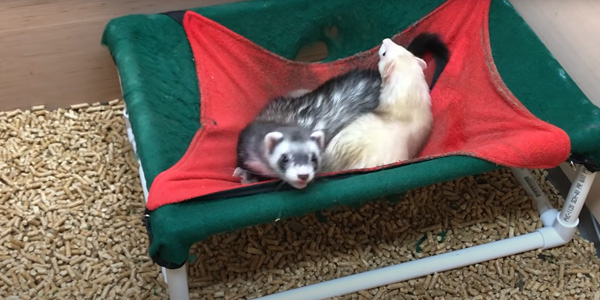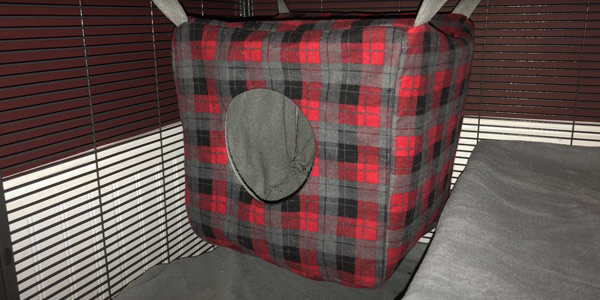As a ferret owner, you already know how much a ferret loves to play. Hence, they don’t enjoy small spaces. As a result, huge spaces should be given to them. And what better way to give them this than a bookshelf.
So, how to make a ferret cage out of a bookshelf?
To make a ferret cage out of a bookshelf you’ll just need a couple of tools. You will require are lumber, a drill machine, a staple gun, drywall, and some screws. First, do the necessary measuring, then build the ramp. Cut the tunnel opening. We’ve also provided other ways to build a ferret cage.
What are you waiting for? Give your ferret the home he/she deserves by diving into this step-by-step guide.
4 Steps to Build Your Ferret Cage

Building a ferret cage out of a bookshelf will be easy if you know how to build a ferret cage out of wood. This one would be the most innovative and convenient to make. Since we all happen to have a bookshelf right at home.
So, follow the steps below to make the best ferret cage.
Step 1: Measuring
Using a ruler, measure the shelf’s depth and mark its centre. Jigsaw a four-inch square based on the shelf’s centre mark. Then sand it down to a smooth finish. Cut 1-by-4-inch lumber to make ramps.
Measure the distance between the two shelves and cut two 1-by-12 timber pieces to that length. You’ll also have to determine the height and width of the bookshelf ferret cages cage wire front.
Step 2: Building The Ramps
Start by cutting holes in all the shelves. Cut the ramps according to the measurement mentioned above. Do this so that the ramp can run between all the shelves.
After running them through the holes, secure them with drywall screws. To avoid splitting the lumber, use a 1/16-inch drill bit to drill pilot holes for the screws. Make sure the ramp sticks far enough through the opening of the shelf. This is for the ferret to reach it safely.
On the top of the ramp, you don’t need a screw.
Step 3: Making The Tunnel Opening
After cutting the lumber into two pieces. Draw a “U” which should be upside down on both the pieces. This “U” will resemble the tunnel opening.
Then proceed to cut the two pieces with a jigsaw. With the drywall screws, secure one tunnel hole between the shelves in the desired spot.
Don’t forget to first drill in the pilot holes. At the appropriate tunnel, length distance put the other tunnel holes. A piece of black fabric should be placed between the two shelves and the openings of the tunnel.
In case you don’t own a drill machine. To make it easier for you we’ve listed below some drill machines you could use-
We hope your drilling experience will be great by using the products above.
Step 4: Making The Cage
Determine the height and width of the cage wire front for the bookshelf ferret cage you are building. For each side, top, and bottom of the bookcase, cut out a piece. That stretches out to the outside edges.
A staple gun and sufficient staples are all that are needed to connect the bookshelf with the cage wire. Stapling length depends on the wire gauge.
Wire cutters can be used to remove a segment (or two) of the cage wire used for the doors. In order to make the cage wire aperture of the four sides smooth, cut the cage wire.
Then cut a piece of cage wire two inches larger than the entrance after measuring it.
A 6-by-8-inch door will fit into a 4-by-6-inch opening, for example.
For further security, use hog rings to secure the door to the cage from behind. You can also put a latch that is already ready-made on the cage. You should be able to put latches on all custom ferret cages.
Other DIY Ferret Cages

In case you don’t want to make a ferret cage out of a bookshelf. These two DIY ferret cage ideas are just as good.
The ideas are listed below.
Repurposed Entertainment Centre
In addition to repurposing old cabinets and other household items, certain entertainment centres can be used as ferret homes. You can use a metal wire front that will stop your ferret from teething its way out.
You can use the bottom drawer as bedding so when cleaning you can just easily slide it open. When building your own reused ferret cage, make sure there aren’t any gaps between the walls or doors.
Also, keep in mind that a ferret’s head can fit through a hole that’s big enough for its body.
Cage Made Out of Rabbit Hutch
Despite their rarity, dedicated ferret cages have many similarities with other animal cages. However, rabbit hutches generally are rather roomy, but they do not have the layers. Usually, ferrets prefer to jump on top of the layers.
You can renovate the hutch to include a ball pool at the bottom, as well as a ferret hammock throughout. Along with the food bowl and water bottle, there is a covered place for sleeping and an easy-access door.
FAQs
Which type of cage is best for ferrets?
Ferrets love to escape from where they are put in. The cage must be safe and secure, with no gaps or openings of any kind. In addition, a vertical cage is preferable over a horizontal one. Because it offers more tiers and stairways for a climber to take advantage of. So the more space you give a ferret the better.
What size should a ferret cage be?
In order to keep ferrets safe, they should be confined in a cage that can be secured and/or shut. Because of their well-deserved reputation as escape artists. The cage should be as big as you can afford; a minimum dimension of 24″ × 24″ x 18″ high could be a good starting point (60 x 60 x 45 cm). Ensure that the cage is well-ventilated.
Is it possible for a ferret to survive in a glass aquarium?
It is not possible for a ferret to survive in a glass aquarium. The amount of waste materials inside the glass tank will be fatal for them. As they could be exposed to dangerous levels of bacteria from the lack of ventilation. Because their urine will eventually turn into ammonia, your ferret’s health could deteriorate.
Endnote
If you’ve read this far we hope by now you know how to build a ferret cage out of a bookshelf. It seems quite hard at first. But it’s the simplest DIY cage for your ferret because half of it is already made!
Also, be sure to make it as big as possible because ferrets love to run and play.
- Can Ducks Eat Mushrooms? [Explained With Facts] - August 17, 2023
- Will Cayenne Pepper Keep Ducks Away? Answered in Detail - August 1, 2023
- Can Geese Eat Bananas? [Properly Answered] - June 27, 2023

